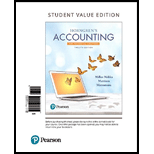
Horngren's Accounting, The Financial Chapters, Student Value Edition Plus MyLab Accounting with Pearson eText - Access Card Package (12th Edition)
12th Edition
ISBN: 9780134642949
Author: Tracie L. Miller-Nobles, Brenda L. Mattison, Ella Mae Matsumura
Publisher: PEARSON
expand_more
expand_more
format_list_bulleted
Question
Chapter 17, Problem S17.3SE
To determine
Trend analysis: It is the analysis of corporate financial performance with the help of ratios. It judges the activities to be performed in future on the basis of activities performed in the past. Percentage of the trend is computed by dividing financial statement’s balance of item of any year with a balance of item in selected base year’s financial statement.
1.
To Calculate: Trend analysis for revenue and net income of M company.
To determine
2.
To Identify: The measure that increased at a higher rate during 2017-19.
Expert Solution & Answer
Want to see the full answer?
Check out a sample textbook solution
Students have asked these similar questions
Assuming a 360-day year, the cash proceeds to Charleston Co. Are
Comparative Income Statements and Basic EPS
Anoka Company reported the following selected items in the shareholders' equity section of its balance sheet on December 31, Year 3, and Year 4:
December 31
Year 4
Year 3
Preferred stock, 7%, 100 par, nonconvertible
$50,000
$50,000
Common stock, $10 par
84,000
70,000
In addition, it listed the following selected pretax items as of December 31, Year 3 and Year 4:
December 31, Year 4
December 31, Year 3
Debit
Credit
Debit
Credit
Sales
$140,000
$124,300
Income from discontinued operations
—
6,000
Cost of goods sold
$80,000
$75,000
Operating expenses
20,000
18,000
Loss from discontinued operations
9,000
—
The preferred shares were outstanding during all of Year 3 and Year 4; annual dividends were declared and paid in each year. During Year 3, 2,000 common shares were sold for cash on October 4. During Year 4, a 20% stock dividend was declared and issued in early May.…
Hi expert provide answer with accounting question
Chapter 17 Solutions
Horngren's Accounting, The Financial Chapters, Student Value Edition Plus MyLab Accounting with Pearson eText - Access Card Package (12th Edition)
Ch. 17 - Prob. 1QCCh. 17 - Prob. 2QCCh. 17 - Prob. 3QCCh. 17 - Prob. 4QCCh. 17 - Prob. 5QCCh. 17 - Prob. 6QCCh. 17 - Prob. 7QCCh. 17 - Prob. 8QCCh. 17 - Prob. 9QCCh. 17 - Prob. 10QC
Ch. 17 - Prob. 1RQCh. 17 - Prob. 2RQCh. 17 - Prob. 3RQCh. 17 - Prob. 4RQCh. 17 - Prob. 5RQCh. 17 - Prob. 6RQCh. 17 - What is benchmarking, and what are the two main...Ch. 17 - Prob. 8RQCh. 17 - Prob. 9RQCh. 17 - Prob. 10RQCh. 17 - Prob. 11RQCh. 17 - Prob. 12RQCh. 17 - Prob. 13RQCh. 17 - Prob. S17.1SECh. 17 - Prob. S17.2SECh. 17 - Prob. S17.3SECh. 17 - Prob. S17.4SECh. 17 - Prob. S17.5SECh. 17 - Prob. S17.6SECh. 17 - Computing inventory, gross profit, and receivables...Ch. 17 - Prob. S17.8SECh. 17 - Measuring profitability Learning Objective 4...Ch. 17 - Prob. S17.10SECh. 17 - Prob. S17.11SECh. 17 - Prob. S17.12SECh. 17 - Prob. E17.13ECh. 17 - Prob. E17.14ECh. 17 - Prob. E17.15ECh. 17 - Prob. E17.16ECh. 17 - Prob. E17.17ECh. 17 - Prob. E17.18ECh. 17 - Prob. E17.19ECh. 17 - Prob. E17.20ECh. 17 - Prob. E17.21ECh. 17 - Prob. E17.22ECh. 17 - Prob. P17.23APGACh. 17 - Prob. P17.24APGACh. 17 - Prob. P17.25APGACh. 17 - Prob. P17.26APGACh. 17 - Using ratios to evaluate a stock investment...Ch. 17 - Prob. P17.28APGACh. 17 - Prob. P17.29APGACh. 17 - Prob. P17.30BPGBCh. 17 - Prob. P17.31BPGBCh. 17 - Prob. P17.32BPGBCh. 17 - Prob. P17.33BPGBCh. 17 - Prob. P17.34BPGBCh. 17 - Prob. P17.35BPGBCh. 17 - Completing a comprehensive financial statement...Ch. 17 - Prob. P17.37CTCh. 17 - Prob. P17.38CPCh. 17 - Prob. 17.1DCCh. 17 - Prob. 17.1EICh. 17 - Financial Statement Case 17-1 Use Target...
Knowledge Booster
Similar questions
- Can you explain the correct approach to solve this general accounting question?arrow_forwardThe standard materials cost to produce 1 unit of Product T is 6 pounds of material at a standard price of $38 per pound. In manufacturing 10,200 units, 50,500 pounds of material were used at a cost of $39 per pound. What is the total direct materials cost variance? A. $14,500 favorable B. $60,500 favorable C. $24,900 unfavorable D. $50,500 unfavorablearrow_forwardI wont to correct answerarrow_forward
arrow_back_ios
SEE MORE QUESTIONS
arrow_forward_ios
Recommended textbooks for you

 AccountingAccountingISBN:9781337272094Author:WARREN, Carl S., Reeve, James M., Duchac, Jonathan E.Publisher:Cengage Learning,
AccountingAccountingISBN:9781337272094Author:WARREN, Carl S., Reeve, James M., Duchac, Jonathan E.Publisher:Cengage Learning, Accounting Information SystemsAccountingISBN:9781337619202Author:Hall, James A.Publisher:Cengage Learning,
Accounting Information SystemsAccountingISBN:9781337619202Author:Hall, James A.Publisher:Cengage Learning, Horngren's Cost Accounting: A Managerial Emphasis...AccountingISBN:9780134475585Author:Srikant M. Datar, Madhav V. RajanPublisher:PEARSON
Horngren's Cost Accounting: A Managerial Emphasis...AccountingISBN:9780134475585Author:Srikant M. Datar, Madhav V. RajanPublisher:PEARSON Intermediate AccountingAccountingISBN:9781259722660Author:J. David Spiceland, Mark W. Nelson, Wayne M ThomasPublisher:McGraw-Hill Education
Intermediate AccountingAccountingISBN:9781259722660Author:J. David Spiceland, Mark W. Nelson, Wayne M ThomasPublisher:McGraw-Hill Education Financial and Managerial AccountingAccountingISBN:9781259726705Author:John J Wild, Ken W. Shaw, Barbara Chiappetta Fundamental Accounting PrinciplesPublisher:McGraw-Hill Education
Financial and Managerial AccountingAccountingISBN:9781259726705Author:John J Wild, Ken W. Shaw, Barbara Chiappetta Fundamental Accounting PrinciplesPublisher:McGraw-Hill Education


Accounting
Accounting
ISBN:9781337272094
Author:WARREN, Carl S., Reeve, James M., Duchac, Jonathan E.
Publisher:Cengage Learning,

Accounting Information Systems
Accounting
ISBN:9781337619202
Author:Hall, James A.
Publisher:Cengage Learning,

Horngren's Cost Accounting: A Managerial Emphasis...
Accounting
ISBN:9780134475585
Author:Srikant M. Datar, Madhav V. Rajan
Publisher:PEARSON

Intermediate Accounting
Accounting
ISBN:9781259722660
Author:J. David Spiceland, Mark W. Nelson, Wayne M Thomas
Publisher:McGraw-Hill Education

Financial and Managerial Accounting
Accounting
ISBN:9781259726705
Author:John J Wild, Ken W. Shaw, Barbara Chiappetta Fundamental Accounting Principles
Publisher:McGraw-Hill Education